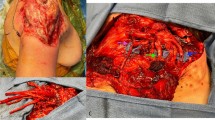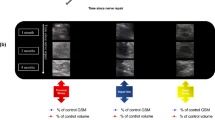Abstract
Targeted muscle reinnervation (TMR) was originally developed as a means for increasing intuitive prosthesis control, though later found to play a role in phantom limb pain and neuroma prevention. There is a paucity of literature describing the clinical course of patients with poor TMR surgical outcomes and the value of imaging in the postoperative recovery period. This report will illustrate the potential utility of ultrasound neurography to accurately differentiate TMR surgical outcomes in two patients that received upper extremity amputation and subsequent reconstruction with TMR. Ultrasound evaluation of TMR sites in patient 1 confirmed successful reinnervation, evident by nerve fascicle continuity and eventual integration of the transferred nerve into the target muscle. Conversely, the ultrasound of patient 2 showed discontinuity of the nerve fascicles, neuroma formation, and muscle atrophy in all three sites of nerve transfer, suggesting an unsuccessful procedure and poor functional recovery. Ultrasound neurography is uniquely able to capture the longitudinal trajectory of rerouted nerves to confirm continuity and eventual reinnervation into muscle. Therefore, the application of ultrasound in a postoperative setting can correctly identify instances of failed TMR before this information would become available through clinical evaluation. Early identification of poor TMR outcomes may benefit future patients by fostering the discovery of failure mechanisms and aiding in further surgical planning to improve functional outcomes.




Similar content being viewed by others
Data Availability
The data that support the findings of this study are available from the corresponding author upon reasonable request.
References
Mereu F, Leone F, Gentile C, Cordella F, Gruppioni E, Zollo L. Control strategies and performance assessment of upper-limb TMR prostheses: a review. Sensors (Basel). 2021;21(6):1953.
Kuiken TA, Dumanian GA, Lipschutz RD, Miller LA, Stubblefield KA. The use of targeted muscle reinnervation for improved myoelectric prosthesis control in a bilateral shoulder disarticulation amputee. Prosthet Orthot Int. 2004;28(3):245–53.
Cheesborough JE, Smith LH, Kuiken TA, Dumanian GA. Targeted muscle reinnervation and advanced prosthetic arms. Semin Plast Surg. 2015;29(1):62–72.
Johnson CC, Loeffler BJ, Gaston RG. Targeted muscle reinnervation: a paradigm shift for neuroma management and improved prosthesis control in major limb amputees. J Am Acad Orthop Surg. 2021;29(7):288–96.
Dumanian GA, Potter BK, Mioton LM, et al. Targeted muscle reinnervation treats neuroma and phantom pain in major limb amputees: a randomized clinical trial. Ann Surg. 2019;270(2):238–46.
Felder JM, Pripotnev S, Ducic I, Skladman R, Ha AY, Pet MA. Failed targeted muscle reinnervation: findings at revision surgery and concepts for success. Plast Reconstr Surg Glob Open. 2022;10(4):e4229.
ElAbd R, Dow T, Jabori S, Alhallabi B, Lin SJ, Dowlatshahi S. Pain and functional outcomes following targeted muscle re-innervation: a systematic review. Plast Reconstr Surg. 2023;Epub ahead of print.
Pet MA, Ko JH, Friedly JL, Mourad PD, Smith DG. Does targeted muscle implantation reduce neuroma pain in amputees? Clin Orthop Relat Res. 2014;472(10):2991–3001.
Rivedal DD, Guo M, Sanger J, Morgan A. Revision targeted muscle reinnervation improves secondary pain insult in an upper extremity amputee: a case report. Hand (N Y). 2021;16(6):NP15–8.
Zaidman CM, Seelig MJ, Baker JC, Mackinnon SE, Pestronk A. Detection of peripheral nerve pathology: comparison of ultrasound and MRI. Neurology. 2013;80(18):1634–40.
Holzgrefe RE, Wagner ER, Singer AD, Daly CA. Imaging of the peripheral nerve: concepts and future direction of magnetic resonance neurography and ultrasound. J Hand Surg Am. 2019;44(12):1066–79.
Ali ZS, Pisapia JM, Ma TS, Zager EL, Heuer GG, Khoury V. Ultrasonographic evaluation of peripheral nerves. World Neurosurg. 2016;85:333–9.
Luzhansky ID, Sudlow LC, Brogan DM, Wood MD, Berezin MY. Imaging in the repair of peripheral nerve injury. Nanomedicine (Lond). 2019;14(20):2659–77.
Lawande AD, Warrier SS, Joshi MS. Role of ultrasound in evaluation of peripheral nerves. Indian J Radiol Imaging. 2014;24(3):254–8.
Gunreben G, Bogdahn U. Real-time sonography of acute and chronic muscle denervation. Muscle Nerve. 1991;14(7):654–64.
Zaidman CM, van Alfen N. Ultrasound in the assessment of myopathic disorders. J Clin Neurophysiol. 2016;33(2):103–11.
Fantoni C, Erra C, Fernandez Marquez EM, et al. Ultrasound diagnosis of postoperative complications of nerve repair. World Neurosurg. 2018;115:320–3.
Lauretti L, D’Alessandris QG, Granata G, et al. Ultrasound evaluation in traumatic peripheral nerve lesions: from diagnosis to surgical planning and follow-up. Acta Neurochir (Wien). 2015;157(11):1947–51.
Author information
Authors and Affiliations
Corresponding author
Ethics declarations
Ethics approval and consent to participate
All procedures performed in studies involving human participants were in accordance with the ethical standards of the institutional and/or national research committee and with the 1964 Helsinki declaration and its later amendments or comparable ethical standards. Specific informed consent was not required by the two individual patients for this study. Rather, all patients at our institution are preoperatively consented for the sharing of non-identifiable information in the form of case reports, including intraoperative and radiologic images. Both study patients signed this preoperative consent.
Conflict of interest
The authors declare no competing interests.
Additional information
Publisher's Note
Springer Nature remains neutral with regard to jurisdictional claims in published maps and institutional affiliations.
Rights and permissions
Springer Nature or its licensor (e.g. a society or other partner) holds exclusive rights to this article under a publishing agreement with the author(s) or other rightsholder(s); author self-archiving of the accepted manuscript version of this article is solely governed by the terms of such publishing agreement and applicable law.
About this article
Cite this article
Finkelstein, E.R., Hui-Chou, H., Fullerton, N. et al. Experience with ultrasound neurography for postoperative evaluation of targeted muscle reinnervation. Skeletal Radiol 53, 811–816 (2024). https://doi.org/10.1007/s00256-023-04441-1
Received:
Revised:
Accepted:
Published:
Issue Date:
DOI: https://doi.org/10.1007/s00256-023-04441-1




